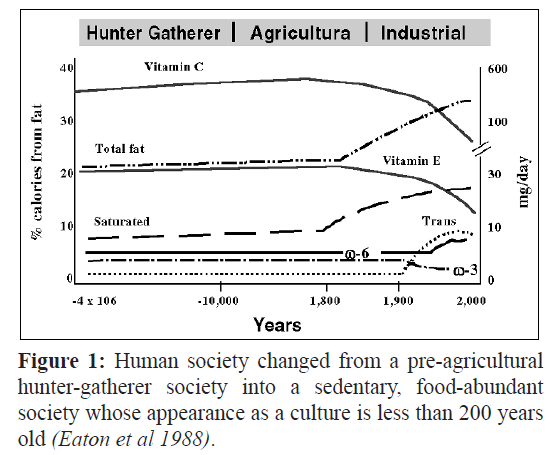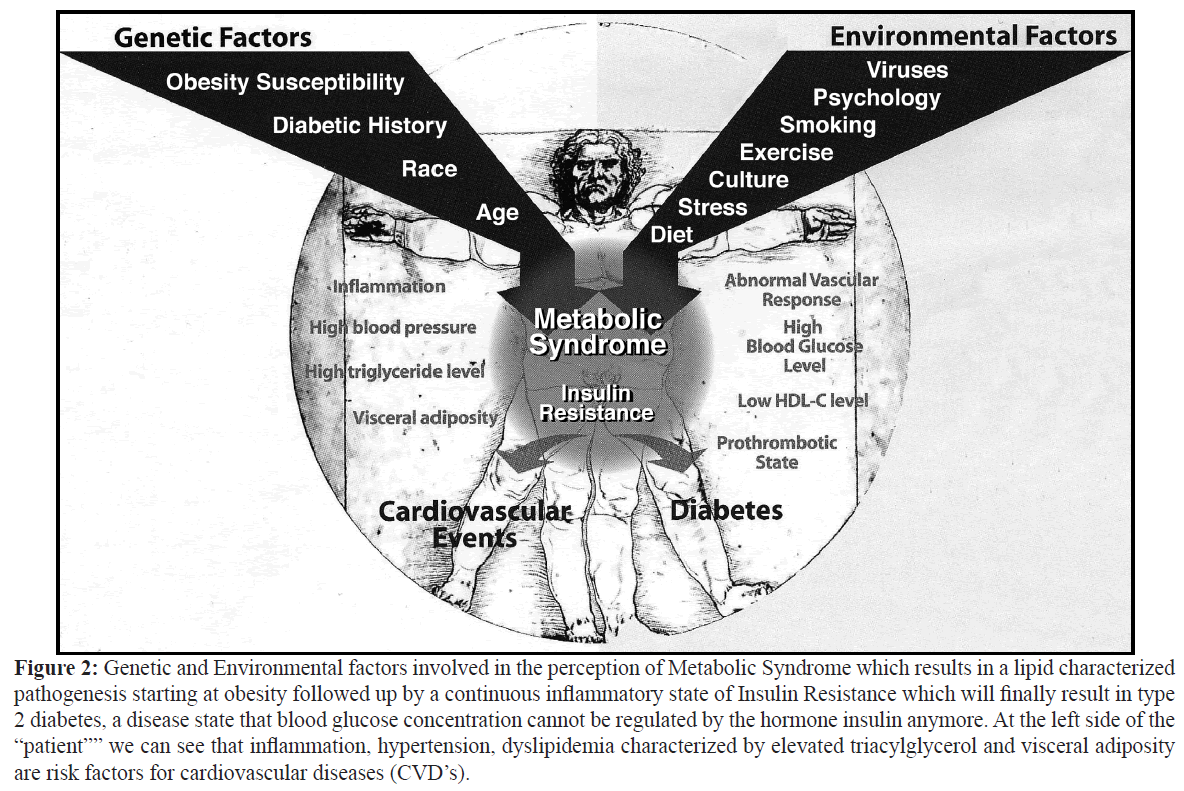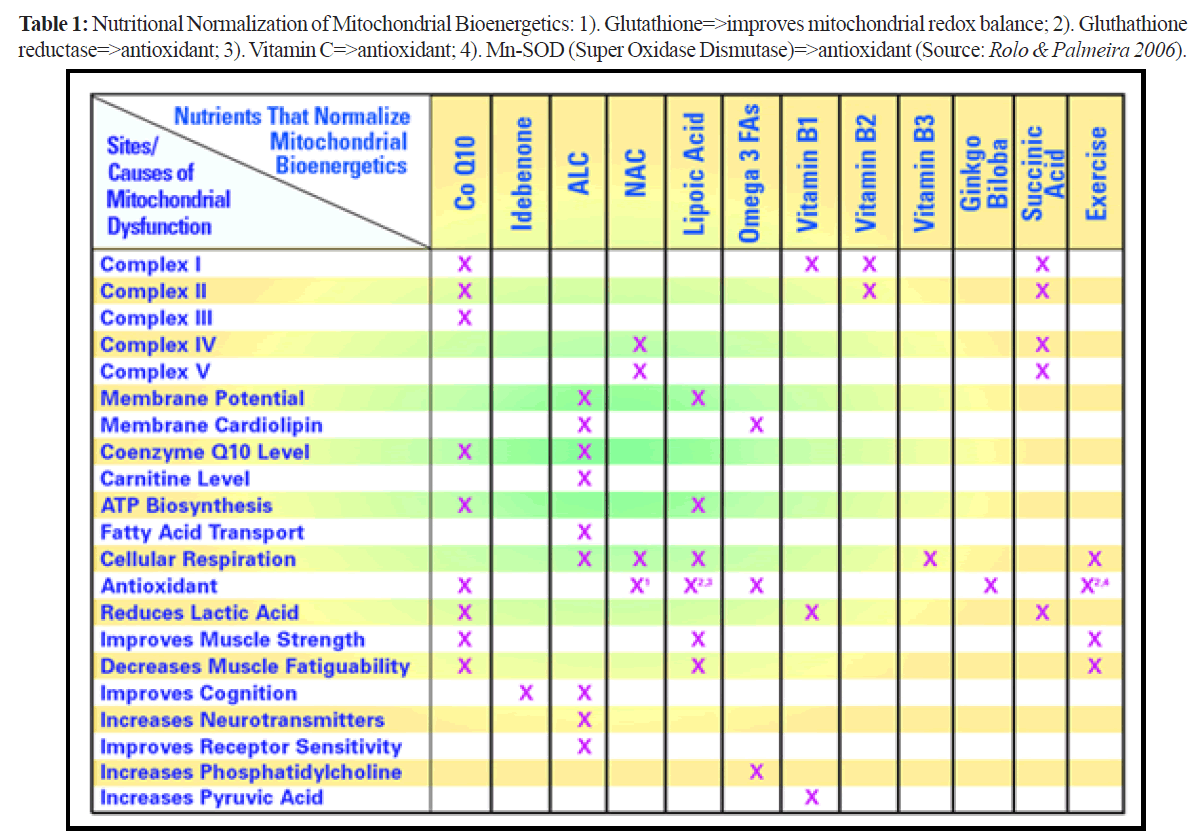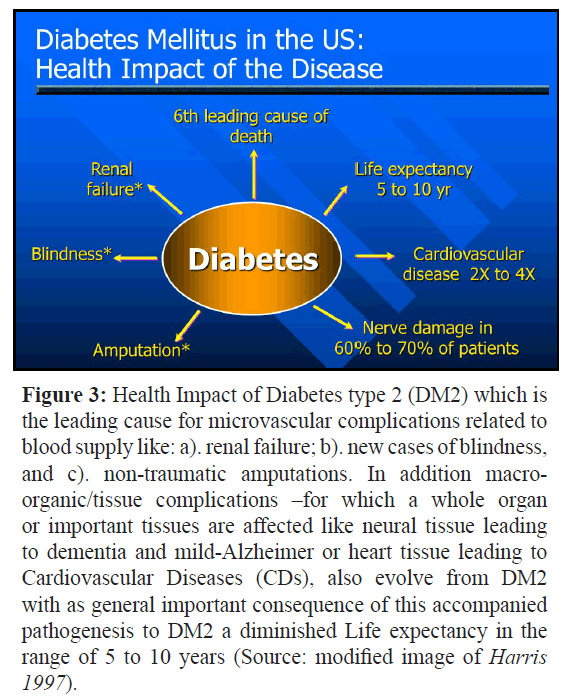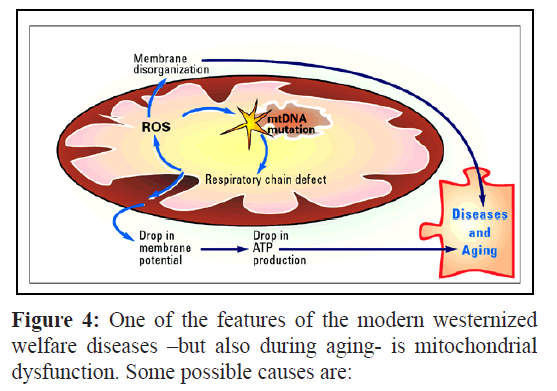2). Krebs’’ cycle decreased efficiency due to inadequate Krebs’ cycle intermediates 3). Respiratory chain defect due to enzyme and/or substrate alterations 4). Membrane disorganization and loss of fluidity.
These are solely some of the factors involved in the complex myriad of the pathogenesis of metabolic syndrome obesity and its ‘burden” of CDDs. The IDF predicts that in 2025 on a world population of ≈8 billion people around one billion people can be diagnosed IR casu quo DM2, while according to the WHO around one billion people will have as a chronic degenerative disease mental disorder -like dementia or mild-Alzheimer- as a consequence of IR/DM2. It is logical that these two organization will focus their activities on the “Developing Countries” and “New Growth Economies” like China and India because more than half of the World-population is living in these two countries. In addition, due to an ageing world, CDDs will affect older adults disproportionally. In the US, approximately 80% of all persons aged >65 years have at least one chronic condition, and 50% have at least two (Andrews 2001).
As a mass phenomenon the current surge in obesity and IR/DM2 and CDDs has no precedent ever before in human history. Around 2010 there were in the U.S. over 133 million people with one or more CDDs. As a result, 70 percent of all deaths were related to these CDCs which correspond to 1.7 million American deaths per year and were responsible for 7 of 10 deaths in the U.S (Pelletier et al. 2009). DM2 and CDDs are related to gender, ethnic group, genetics (≈ thrifty genes) (van Ginneken et al 2011a), but also to changes in our Western-diet of modern man in comparison to the traditional hunter-gatherer diet. The traditional Paleolithic diet could be evaluated based on comparison of nutritional compounds of 229 contemporary still existing hunter gatherer societies for which research indicated that these people were relatively free of many of the CDDs symptoms which probably could be explained by diet and lifestyle (van Ginneken & de Vries 2015).
In Figure 5 is symbolically the external feature of a similar Homo sapiens depicted starting as Hunter-gatherer two million years ago with the healthy man of the 20st Century and the phenotype of the modern “office worker”, all mainly caused by changed nutritional patters in combination with a sedentary life style (Handschin & Spiegelman 2008). Some of these changes for the modern ‘office worker’ A.D. 2012 are refined vegetable oils increased saturated-, trans- and total-fat consumption, increased refined sugars (mainly fructose), replacement of high protein meat by carbohydrate rich cereals, increased Ω6/Ω-3 ratio (van Ginneken et al 2011b) and reduced daily physical activity (Handschin & Spiegelman 2008), gave growing awareness that these profound changes that begin with the ‘Agricultural revolution’ ≈10,000 years ago, followed by ‘Industrial revolution’ ≈ 200 years ago more recently ≈3 decades ago to our ‘modern Westernized welfare diet’ over all resulted in a diet which can be characterized by food ingredients which were unfamiliar to the hunter gatherer diet such as dairy products, cereals, refined sugars, refined vegetable oils. Several food ingredients rarely or never consumed during previous stages of Pleistocene, a period of ≈2 million years evolution. The transition period of hunter gatherer during late Paleolithic period as hunter gatherers towards farmers due to the discovery of Agriculture, with all its new food products like cereals, milk and cultured low quality fatty meat our body was not used to (Eaton & Konner 1985). It has to be suggested by geneticists that this 10,000 years period was not extended enough to adapt genetically and metabolically to the westernized diet of the “modern office worker” A.D. 2012 for nutritional macroelements (Table 1 in van Ginneken & de Vries 2015).
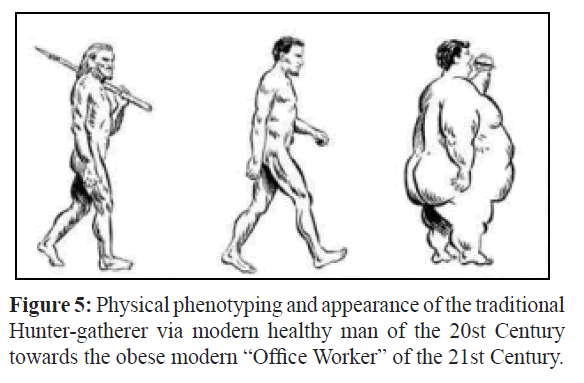
Figure 5: Physical phenotyping and appearance of the traditional Hunter-gatherer via modern healthy man of the 20st Century towards the obese modern “Office Worker” of the 21st Century.
Some Biochemistry in Relation to Micro- Elements (Vitamins and Minerals)
In the cytosol the first step to generate some ATP by fermentation is the (1) Glycolysis in the cytosol where not many vitamins or coenzymes are involved. This is different for the mitochondria with the spinning (2) Krebs’ cycle and the (3) Oxidative phosphorylation linked to the respiratory chain. An overview of these 3 ATP producing processes and its location in the cell or the mitochondrial organelle is given in Figure 6.
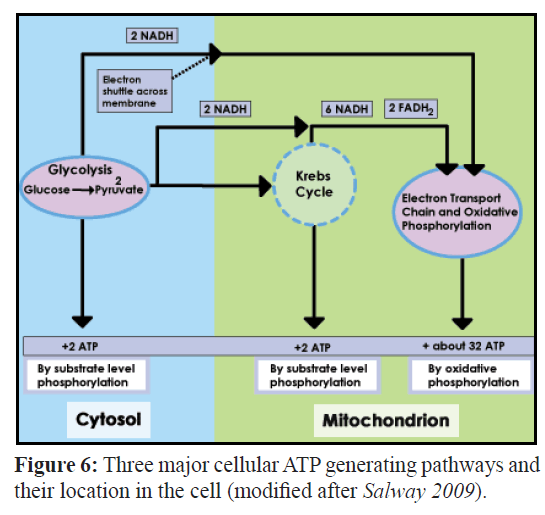
Figure 6: Three major cellular ATP generating pathways and their location in the cell (modified after Salway 2009).
We stipulate in this paragraph to keep in mind that the mitochondrial role in energy production is accomplished by two closely linked metabolic processes: 2) “Spinning” Krebs’ cycle and 3) Oxidative Phosphorylation (Salway 2010).
1) Vitamins and coenzymes involved in cytosolic glycolysis (Figure 7): During the glycolysis conversion of carbohydrates into fatty acids and cholesterol is performed. Cholesterol can, in turn, be used to synthesize the steroid hormones, bile salts, and vitamin D (Voet et al 2006). Vitamin D refers to a group of fat-soluble secosteroids responsible for enhancing intestinal absorption of calcium, iron, magnesium, phosphate and zinc. In humans, the most important compounds in this group are vitamin D3 (also known as cholecalciferol) and vitamin D2 (ergocalciferol) (Holick 2006). Cholecalciferol and ergocalciferol can be ingested from the diet and from supplements. Very few foods contain vitamin D; synthesis of vitamin D (specifically cholecalciferol) in the skin is the major natural source of the vitamin. Dermal synthesis of vitamin D from cholesterol is dependent on sun exposure (specifically UVB radiation). Nicotinamide adenine dinucleotide (NAD) is a coenzyme found in all living cells. The compound is a dinucleotide, because it consists of two nucleotides joined through their phosphate groups. One nucleotide contains an adenine base and the other nicotinamide. Nicotinamide adenine dinucleotide exists in two forms, an oxidized and reduced form abbreviated as NAD+ and NADH respectively (Stryer 1988). In metabolism, nicotinamide adenine dinucleotide (NADH) is involved in redox reactions, carrying electrons from one reaction to another. The coenzyme is, therefore, found in two forms in cells: NAD+ is an oxidizing agent – it accepts electrons from other molecules and becomes reduced. This reaction forms NADH, which can then be used as a reducing agent to donate electrons. These electron transfer reactions are the main function of NAD. However, it is also used in other cellular processes, the most notable one being a substrate of enzymes that add or remove chemical groups from proteins, in posttranslational modifications (Stryer 1988, Salway 2010). In organisms, NAD can be synthesized from simple building-blocks (de novo) from the amino acids tryptophan or aspartic acid. In an alternative fashion, more complex components of the coenzymes are taken up from food as the vitamin called niacin (Rolfes et al 2009). Niacin (also known as vitamin B3 or nicotinic acid) is an organic compound with the formula C6H5NO2 and, depending on the definition used, one of the 20 to 80 essential human nutrients. Pharmaceutical and supplemental niacin are primarily used to treat hypercholesterolemia (high cholesterol) and pellagra (niacin deficiency). Insufficient niacin in the diet can cause nausea, skin and mouth lesions, anemia, headaches, and tiredness. The lack of niacin may also be observed in pandemic deficiency disease, which is caused by a lack of five crucial vitamins (niacin, vitamin C, thiamin, vitamin D, and vitamin A) and is usually found in areas of widespread poverty and malnutrition (Rolfes et al 2009).
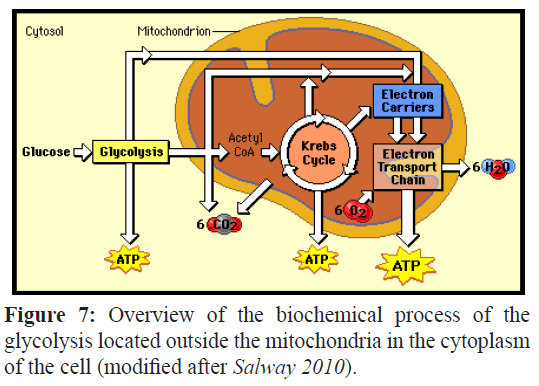
Figure 7: Overview of the biochemical process of the glycolysis located outside the mitochondria in the cytoplasm of the cell (modified after Salway 2010).
2) Krebs’ cycle (also known as the Citric Acid cycle, or Tri- Carboxylic-Acid (TCA) cycle:
The Krebs’ or citric acid cycle (Figure 8) converts biological fuel (carbohydrates and fats) into adenosine triphosphate (ATP). ATP is the body’s principal source of cellular energy. The Krebs cycle is a series of enzymatic reactions that catalyzes the aerobic metabolism of fuel molecules to carbon dioxide and water, thereby generating energy for the production of adenosine triphosphate (ATP) molecules. Many types of fuel molecules can be drawn into and utilized by the cycle, including acetyl coenzyme A (acetyl CoA), derived from glycolysis or fatty acid oxidation . Some amino acids are metabolized via the enzymatic reactions of the Krebs cycle. In eukaryotic cells, all but one of the enzymes catalyzing the reactions of the Krebs cycle is found in the mitochondrial matrixes. The sequence of events known as the Krebs cycle is indeed a cycle; oxaloacetate is both the first reactant and the final product of the metabolic pathway (creating a loop). Because the Krebs cycle is responsible for the ultimate oxidation of metabolic intermediates produced during the metabolism of fats, proteins, and carbohydrates, it is the central mechanism for metabolism in the cell. In the first reaction of the cycle, acetyl CoA condenses with oxaloacetate to form citric acid. Acetyl CoA utilized in this way by the cycle has been produced either via the oxidation of fatty acids, the breakdown of certain amino acids, or the oxidative decarboxylation of pyruvate (a product of glycolysis). The citric acid produced by the condensation of acetyl CoA and oxaloacetate is a tri carboxylic acid containing three carboxylate groups. (Hence, the Krebs cycle is also referred to as the citric acid cycle or tricarboxylic acid cycle.) After citrate has been formed, the cycle machinery continues through seven distinct enzyme-catalyzed reactions that produce, in order, isocitrate, α -ketoglutarate, succinyl coenzyme A, succinate, fumarate, malate, and oxaloacetate. The freshly produced oxaloacetate, in turn, reacts with yet another molecule of acetyl CoA, and the cycle begins again. Each turn of the Krebs cycle produces two molecules of carbon dioxide, one guanosine triphosphate molecule (GTP), and enough electrons to generate three molecules of NADH and one molecule of FADH2. The Krebs cycle is present in virtually all eukaryotic cells that contain mitochondria, but functions only as part of aerobic metabolism (when oxygen is available). This oxygen requirement is owing to the close relationship between the mitochondrial electron transport chain and the Krebs cycle. In the Krebs cycle, four oxidation–reduction reactions occur. A high energy phosphate bond in the form of GTP is also generated. (This high energy phosphate bond is later transferred to adenosine diphosphate [ADP] to form adenosine triphosphate [ATP].) As the enzymes of the Krebs cycle oxidize fuel molecules to carbon dioxide, the coenzymes NAD+, FAD, and coenzyme Q (also known as ubiquinone) are reduced. In order for the cycle to continue, these reduced coenzymes must become re-oxidized by transferring their electrons to oxygen, thus producing water. Therefore, the final acceptor of the electrons produced by the oxidation of fuel molecules as part of the Krebs cycle is oxygen. In the absence of oxygen, the Krebs cycle is inhibited. The citric acid cycle is an amphibolic pathway, meaning that it can be used for both the synthesis and degradation of biomolecules. Besides acetyl CoA (generated from glucose, fatty acids, or ketogenic amino acids), other biomolecules are metabolized by the cycle. Several amino acids are degraded to become what are intermediates of the cycle. Likewise, odd-chain fatty acids are metabolized to form succinyl coenzyme A, another intermediate of the cycle. Krebs cycle intermediates are also used by many organisms for the synthesis of other important biomolecules (Stryer 1988, Lin & Beal 2006; Rolfes et al 2009; Salway 2010).
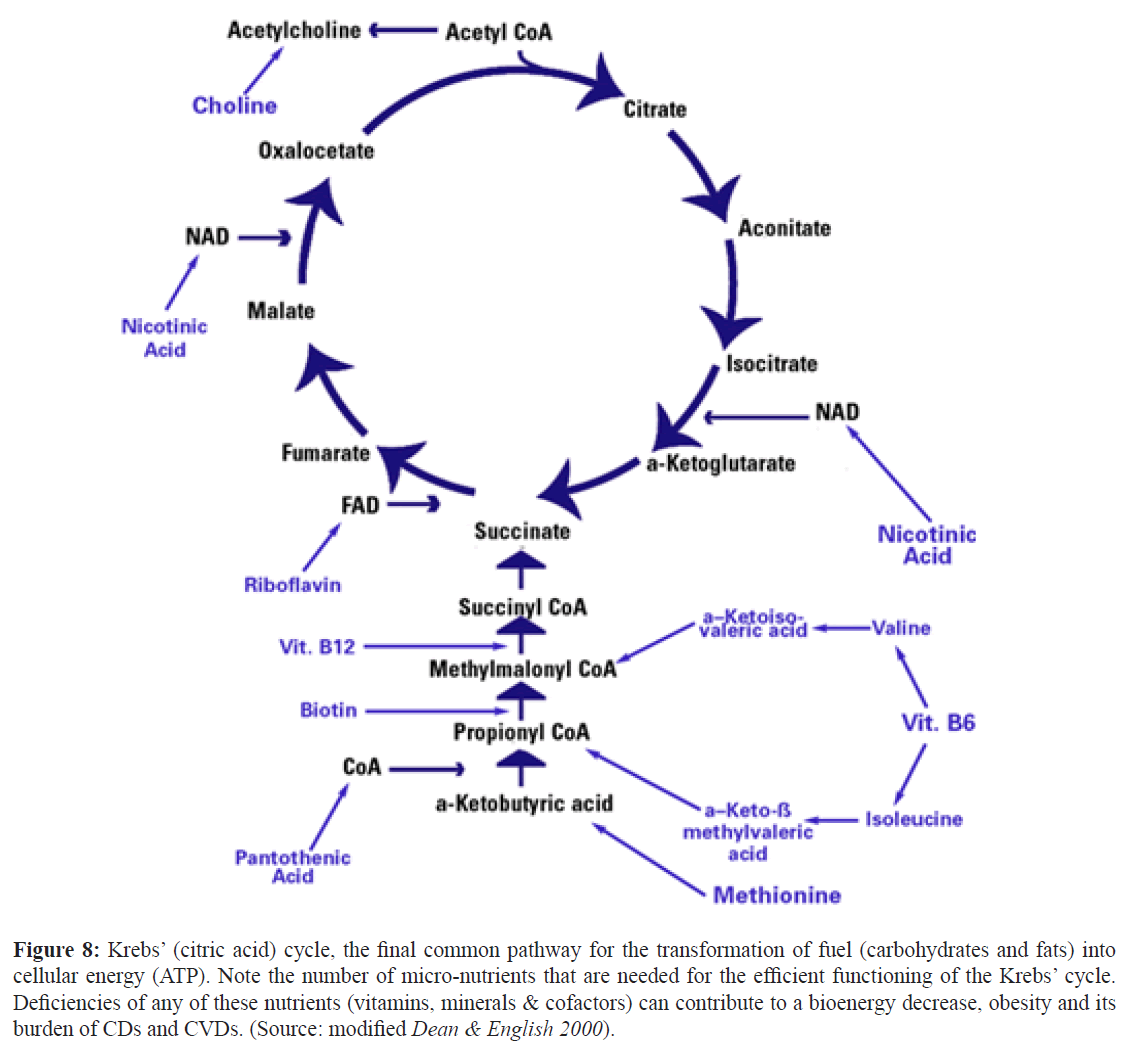
Figure 8: Krebs’ (citric acid) cycle, the final common pathway for the transformation of fuel (carbohydrates and fats) into cellular energy (ATP). Note the number of micro-nutrients that are needed for the efficient functioning of the Krebs’ cycle. Deficiencies of any of these nutrients (vitamins, minerals & cofactors) can contribute to a bioenergy decrease, obesity and its burden of CDs and CVDs. (Source: modified Dean & English 2000).
3) OxidativePhosphorylation (OXPHOS) (Salway 2010): The other process—oxidative phosphorylation (OXPHOS)—combines hydrogen with oxygen to generate even larger amounts of ATP. OXPHOS generates about ten times more ATP than the citric acid cycle. Oxidative phosphorylation is the primary energy process for all aerobic organisms. Mitochondrial oxidative phosphorylation (OXPHOS) provides over 80 percent of the ATP used by our cells for energy. OXPHOS operates very efficiently—close to 70 percent. Mitochondrial energy production is an absolute necessity for physical strength, energy, stamina, and life itself (Table 1). The slightest drop in mitochondrial energy output, no matter how subtle, can lead to weakness, fatigue and cognitive difficulties (Lin & Beal 2006). Unfortunately, during obesity and its “burden” of CDs but also during aging, mitochondrial function becomes less efficient.
Seaweeds as a source for essential Vitamins & minerals
Seaweeds or macroalgae have been a source of food, feed and medicine in the Orient as well as the West since ancient times. Being plants of unique structure and biochemical composition, seaweeds could be exploited for their multifunctional properties. They are sources of useful bioactive components like phycocolloids, proteins, vitamins & minerals, carotenoids like fucoxanthin and n3 fatty acids, which are known to possess nutritional value apart from their potential biomedical applications (Chandini et al 2008, Hurd et al 2014). Naturally growing seaweeds are an important source of food, especially in Asia. They provide many vitamins including: A, B1, B2, B6, niacin and anti-oxidative C, and are rich in iodine, potassium, iron, magnesium and calcium (Simoons 1991). The comprehensive review of MacArtain et al (2007) presents information on the nutritional aspects of seaweeds in terms of fibre, mineral content, fats and lipids, vitamin contents, and components that have a confirmed and investigated nutritional effect and are of devastating importance in the prevention of obesity, type 2 diabetes and its burden of CDs. Now we know in great extent the essential role of vitamins in our three major biochemical pathways (1). Glycolyis; (2). Krebs’ & (3). OXPHOS), Table 2 derived from the basic fundamental “Understanding Normal and Clinical Nutrition” (Rolfes et al 2009), reflects an alarming and shocking perception on the quality of our modern westernized food in comparison to a Paleolithic diet (Jews et al 2009). In this riveting and unique scholar classic clinical nutrition book also is tabulated for a variety of common food stuffs in the US the food composition for macro-nutritional ingredients as well for vitamins and minerals. The outcomes are devastating and alarming and demonstrate clearly the lack of essential vitamins & minerals in our common western food (Rolfes et al 2009). www.fisheriessciences. com/fisheries-aqua/1307-234X-10-033s.zip
A brief selection for common “fast food” restaurants and companies is depicted in Table 2. The neutral reader shall be overwhelmed and convinced that the quality of our modern westernized food at macro- and micro-element level is clearly out of synch with our biochemical pathways and routes involved in our respiration and metabolism. So our first manuscript “towards a Seaweed based Economy”, has clearly outlined at macronutritional level the unhealthy properties of macro ingredients in the westernized diet of the “modern office worker” (van Ginneken & de Vries 2015) while in this manuscript our focus is on microelements like vitamins and minerals. An example of the required micro-elements in an original Paleolithic diet is given by Jews et al (2009) and depicted in Table 3 below.
| Macro- and micro- nutritional component |
A): Paleolithic intake |
B): Current intake |
(A/B)-fold |
| Protein (% energy) |
37 |
14.7 |
125.2 |
| Carbohydrate (% energy) |
41 |
51.9 |
79.0 |
| Fat (% ) |
22 |
32.7 |
67.3 |
| [Polyunsaturated fat : saturated fat]-ratio |
1.4 |
0.6 |
2.33 |
| [Ω-6 fatty acid : Ω-3 fatty acid]-ratio |
1.0 : 1.0 |
9.8 : 1 |
0.10 |
| Cholesterol (mg) |
480 |
265 |
1.81 |
| Fibre (g) |
104 |
15.2 |
6.84 |
| Riboflavin (mg) |
6.49 |
2 |
3.25 |
| Folate (mg) |
357 |
361 |
0.99 |
| Thiamin (mg) |
3.91 |
1.6 |
2.44 |
| Vitamin C (mg) |
604 |
97 |
6.23 |
| Vitamin A (mg of retinol equivalent) |
2870 |
983 |
2.92 |
| Vitamin E (mg) |
32.8 |
8.8 |
3.73 |
| Iron (mg) |
87.4 |
15.2 |
5.75 |
| Zinc (mg) |
43.4 |
11.4 |
3.81 |
| Calcium (mg) |
1,956 |
863 |
13.85 |
| Sodium (mg) |
768 |
3,375 |
0.23 |
| Potassium (mg) |
10.500 |
2.628 |
4.00 |
Table 3: Comparison of the Paleolithic Diet vs. Current Westernized Diet for macro- & micro-nutritional components and its ratio (Modified after Jews et al 2009 and references therein).
Does The Palaeolithic Diet Actually Work?
The contemporary American diet figures centrally in the pathogenesis of numerous chronic diseases-'diseases of civilization'. The contemporary American diet figures centrally in the pathogenesis of numerous chronic diseases--'diseases of civilization'--such as obesity and diabetes. We investigated in type 2 diabetes whether a diet similar to that consumed by our pre-agricultural hunter-gatherer ancestors (Palaeolithic-type diet) confers health benefits. We briefly review studies in humans whether a diet similar to that consumed by our pre-agricultural hunter-gatherer ancestors (that is, a Paleolithic type diet) confers health benefits.The traditional Palaeolithic diet existed based on a comparison of nutritional compounds of 229 contemporary still existing hunter gatherer societies (van Ginneken & de Vries 2015), combined with research from the research areas of gastro-entereology, archaeology, anthropology, ethnobotany, evolutionary sciences, biology, genetics and clinical nutrition research. Recent epidemiologic studies have revealed a high prevalence of maturity-onset diabetes in certain populations that have undergone comparatively rapid urbanization. The rationale for these early studies at traditional hunter gatherer societies was that temporarily reversing the urbanization process in diabetic Australian Aborigines should improve all aspects of their carbohydrate and lipid metabolism that are linked to insulin resistance. Early studies at this original Australian minority group performed in the eighties of the previous century suggested that Australian Aborigines may respond to urbanization in this way (O’Dea et al 1980; O’Dea 1984). In the first Australian Aborigines study of O’Dea et al (1980), Thirteen “full-blood” Aborigines from the Mowanjum Community, Derby, Western Australia, cooperated in the present study. They spent 3 months living in their traditional hunter-gatherer life-style, after which their insulin response to glucose was measured in a starch tolerance test. The findings were compared in follow-up studies conducted 3 months after returning to their urban environment. Similar studies were conducted in Caucasians of comparable age and weight. Fasting glucose concentrations were lower in Aborigines than in Caucasians and were unaffected by life-style changes. Although basal insulin levels were similar in the three groups, there were striking intergroup differences in the insulin responses to glucose. This appeared to reflect differences in the early rates of change of glucose concentrations. The data suggest that these Aborigines have an abnormally high insulin response to glucose, which is ameliorated, but not normalized, by reverting to their traditional life-style (O’Dea et al (1980). In the second Australian Aborigines study of O’Dea (1984), ten full-blood, diabetic Aborigines from the Mowanjum Community (Derby, Western Australia) agreed to be tested before and after living for 7 weeks as hunter-gatherers in their traditional country in north-western Australia. They were middle aged (53.9 ± 1.8 y) and overweight (81.9 ± 3.4 kg), and all lost weight steadily over the 7-wk period (average, 8 kg). A detailed analysis of food intake over 2 weeks revealed a low-energy intake (1200 kcal/person/day). In this study, ten diabetics lived as hunter-gatherers for 7 weeks and had incredible improvements in health. Very interesting study, but there are too many confounders to conclude anything about the diet itself.However within the complicated nexus of an urbanized environment vs. their traditional ancestors environment its insights of these two studies (O’Dea et al 1980; O’Dea 1984) have to this point been appreciated only by a relatively few researchers and it is still very controversial among health professionals and mainstream nutrition organizations. Some have embraced the diet as healthy and reasonable, while others think it is downright harmful. So we can conclude that the study of evolutionary relationship to health and the repercussions of evolution and discordance on human biology is still in its infancy. Fortunately –at present- science can give us some answers here, because 6 clinical human studies have been performed on the Palaeolithic diet so far which we will discuss in the next section summarizing their major findings at the end. In the next paragraph will six human intervention studies be discussed that have been conducted on the Paleolithic diet, looking at body weight and various health markers. So, only human studies that isolate diet as the sole variable were included in our analysis with as central question “Does the Palaeolithic Diet works?” (vide: BOX-1).
Can we conclude based these 6 pioneering human Palaeolithic studies (BOX-1) it works?
Our first conclusion related to a “Clinical Nutrition approach” (Rolfes et al 2009) is that overall in these human pioneering studies, the Palaeolithic diet was very well tolerated by human volunteers and there were no reports of adverse effects. Secondly, critically reviewing these first 6 Palaeolithic studies we have to mention the following “experimental flaws” and several obvious limitations to these 6 studies: a) All 6 studies were small, ranging from 9-29 participants; b) Studies did not last very long, ranging from 10 days to 12 weeks; c) Only 2 out of 6 studies had a control group. So from clinical medical nutrition perspectives (Rolfes et al 2009), we are still literally at the “Neolithic Phase” in appropriate medical clinical studies in order to propagate our “Stone-aged” Palaeolithic diet. We hope by our uncontroversial but as “challenge for modern clinical science” to give convincing evidence that the following statement is true:
"The wise man should consider that health is the greatest of human blessings.
Let food be your medicine."
Hippocrates (c. 460 BC – c. 370 BC)
Moreover, preliminary intervention studies using contemporary diet based on Paleolithic food groups (meat, fish, shellfish, fresh fruits and vegetables, roots, tubers, eggs, and nuts), revealed promising results including favorable changes in risk factors, such as weight, waist circumference, C-reactive protein, glycated haemoglobin (HbAlc), blood pressure, glucose tolerance, insulin secretion, insulin sensitivity and lipid profiles. Additionally, more studies are needed to determine the impact of lack of micro- nutrients & elements and cofactors on metabolic syndrome, obesity and its burden of CDs. Although limited literature is available on this topic one convincing Saudi Arabia pilot study gave convincing evidence that lack of dietary micronutrient factors like vitamins A, C, E and K, and the microelements calcium, zinc and magnesium had a major influence in the Saudi Arabic female group with Metabolic Syndrome (Al-Daghri et al 2013). Obviously we can’t make any firm conclusions based on these six studies alone, since they are too small and too short in duration. However, the little evidence we do have is very promising and we can see it at presently as the solely solution to cope on a global scale with the tremendous economical medical costs which accompany obesity and its burden of CDs. Also our biochemical arguments in the comparison of the required micro-elements (vitamins & minerals) needed in our several biochemical ATP generating routes (glycolysis, Krebs’ & Oxidative Phosphorylation) clearly demonstrates what “the metabolic machinery of our 2 million years old still hunter gatherer needs to operate properly. As one of the “highlights” of this review is a reflection of the nowadays modern daily “fast food” diet depicted in Table 2, which summarizes the vitamins and minerals present on our modern westernized welfare food which we daily consume (Source: Rolfes et al 2009). Clearly is visible the nearly complete lack of vitamins & minerals in the food of the “Modern Office Worker”. This [Mini-review]: is according to our perception the first study where at the biochemical level is explained why lack of nutritional micro-elements has a causative effect on the nowadays raising pandemic of obesity and its burden of Chronic Degenerative welfare diseases (CDs). Our next paragraph will give a solution based on a “substitute-Palaeolithic diet”, which can produced for our global population, estimated at around 10 billion people at the midst of the 21st century. Because our oceans cover ≈¾ of the surface of our planet they can produce a healthy “substitute”-Palaeolithic diet, not solely for “ the global ten billion people issue” at the midst of the 21st century but for coming generations and far beyond.
Is reintroduction of the Paleolithic diet for ten billion people in the 21st century possible?
Our society changed from a pre-agricultural hunter-gatherer society into a sedentary, food abundant society whose appearance as a culture is less than 200 years old, in the overall timeframe of human existence corresponds to 0.4% (Lieberman 2003, van Ginneken 2012). Anthropological and medical studies of 229 contemporary still existing hunter-gatherer societies listed in the Ethnographic Atlas, indicate that these people were relatively free of many of the “chronic degenerative welfare diseases” (CDs) and disease symptoms that plague modern Westernized societies. As a very convincing “principle of proof” Liebermann (2003) cites the very important and convincing study of O’Dea et al 1980, that people from origin belonging to Australian Aborigines, a modern contemporary hunter gatherer society -who were adapted to a modern urbanized lifestyle- but temporarily during this experiment converted to their traditional foraging lifestyle, directly responded with reduced serum insulin and glucose levels. These are all parameters directly related to Insulin Resistance and/or Type 2 Diabetes pathogenesis and may be indicative for a reversal of the Type 2 Diabetes pathogenesis by regaining their traditional hunter gatherer diet including lifestyle !!. This experiment gives supportive evidence for the statement “You are what you eat”, but most of all in the timeframe of the existence of the hominids and early Homo sapiens - a time period covering almost 2 million years - “You are what your ancestors -the hunter-gathererseat” (Eaton & Konner 1985). Because the estimated amount of genetic change (0.005%) which has occurred in the human genome over this time period of 2 million years since early Homo sapiens appeared at late Palaeolithic time is negligible, it is a legitimate assumption that the genetic make-up of modern man has remained essentially unchanged from that of pre-agricultural man. Consequently, the human genome is most ideally adapted to those foods which were available to pre-agricultural man, namely lean muscle meats, limited fatty organ meats, and wild fruits and vegetables. But, significantly, no grains, legumes, dairy products, or the very high-fat carcasses of modern domesticated animals products of agricultural practices evolving≈5,500-10,000 ago, which corresponds to ≈400-500 human generations. Anthropologic and medical studies of hunter-gatherer societies indicate that these people were relatively free of many of the chronic degenerative diseases and disease symptoms (Eaton et al. 1988) that plague modern societies and that this freedom from disease was attributable in part to their diet (reviewed: Cordain et al. 2005). Indeed we can conclude that human diet changed with introduction of agriculture around 10,000 years ago. But based on the time-period we lived as hunter-gatherers and have eaten the Paleolithic diet this corresponds to a period of two million years. So introduction of agriculture (Neolithic revolution) in the overall timeframe of human existence corresponds to 0.4%. Because the estimated amount of genetic change (0.005%) which has occurred in the human genome over this time period is negligible, the genetic make-up of modern man has remained essentially unchanged from that of pre-agricultural man (Eaton & Konner 1985). Consequently, the human genome is most ideally adapted to those foods which were available to pre-agricultural man, namely lean muscle meats, limited fatty organ meats, and wild fruits and vegetables-but, significantly, not grains, legumes, dairy products, or the very High-fat carcasses of modern domesticated animals. There is general consensus about the potential mismatch between the growth trajectories of worldwide human population and its food production systems (McMichael 2005; Eicimovic 2007). Nowadays our modern industrialized agricultural system is focused to ensure stable food production of dietary energy for the growing world population. According to the Food and Agricultural Organization, global food production reached about 2,600 kcal/capita/day and is projected to reach almost 3,000 kcal by 2030 (reviewed: Caballero 2007). So our agricultural food production system nowadays is focused on quantity and dietary energy security. The evolutionary consequence of our changed lifestyle since agricultural revolution may result in chronic degenerative diseases like IR/DM2. However, like we described in earlier in this review from biochemical perception –with focus on the micro-nutrients (vitamins & minerals) the quality of the food, considering like earlier discussed (van Ginneken & de Vries 2015), for macro-nutritional commodities like: Plant/ animal ration (in % based on energy value), fiber consumption (g/caput/day), total dietary energy (kcal/caput/day), protein(/%)/ carbo-hydrate(%)/fat(%), saturated-fat (% calories from total fat), trans-fat (% of total dietary input), fructose, ω6/ω3 ratio PUFA, in order to prevent chronic degenerative diseases like IR/DM2. For proteins it has been demonstrated that High-protein diets may have cardiovascular protective effects due to a higher thermogenic effect increasing the metabolic rate and thus burning excessive body fat (Paoli et al 2013) and, in combination with exercise can combat Obesity induced sarcopenia which is a characteristic for an elderly population with an extending Life-span (Lutz et al. 2008). Furthermore, carbohydrate restriction may help prevent Obesity and DM2 in combination with lowering of the lipogenic refined sugar fructose. This dietary monosaccharide is in our species metabolically not regulated but is however nowadays added by our industry to our foodstuff in great amounts in this was further increasing the problem of IR/DM2. Furthermore decreased saturated-, trans- and total-fat, increasing protein content of a meal by lean meat but also increase protein content of the food by increased fish consumption with as other beneficial profit a decreased Ω6/Ω-3 ratio and the loose of a sedentary life-style by increased physical daily activity are all mechanisms/prevention therapies/nutritional interventions to cope with the pathogenesis of IR/DM2. In this review we gave at micro-nutrient level convincing evidence which are the requirements for a healthy high qualitative “Paleolithic” diet on basis of the required micronutrients (vitamins & minerals), in order to meet the demands of our “hunter-gatherer” two million years old “metabolic machinery”.
| BOX-1: DOES THE PALEOLITHIC DIET WORKS? |
Study 1: “A Palaeolithic diet improves glucose tolerance more than a Mediterranean-like diet in individuals with ischaemic heart disease”(Lindeberg et al 2007).
- Details: 29 men with heart disease and elevated blood sugars or type 2 diabetes, were randomized to either a Paleolithic diet (n=14) or a Mediterranean-like diet (n=15). Neither group was calorie restricted
- The main outcomes measured were glucose tolerance, insulin levels, weight- and waist- circumference. This study went on for 12 weeks Glucose Tolerance: The glucose tolerance test measures how quickly glucose is cleared from the blood. It is a marker for insulin resistance and diabetes Weight Loss: Both groups lost a significant amount of weight, 5 kg (11 lbs) in the paleo group and 3.8 kg (8.4 lbs) in the control group. However, the difference was not statistically significant between groups. The paleo diet group had a 5.6 cm (2.2 inches) reduction in waist circumference, compared to 2.9 cm (1.1 inches) in the control group. The difference was statistically significant A few important points:
- The 2-hour “Area under the Curve” (AUC) for blood glucose went down by 36% in the paleo group, compared to 7% in the control group.
- Every patient in the paleo group ended up having normal blood sugars, compared to 7 of 15 patients in the control group.
- The paleo group ended up eating 451 fewer calories per day (1344 compared to 1795) without intentionally restricting calories or portions.
Conclusion: A Palaeolithic diet lead to greater improvements in waist circumference and glycemic control, compared to a Mediterranean-like diet.
|
Study 2: Osterdahl M, et al. (2008). “Effects of a short-term intervention with a Palaeolithic diet in healthy volunteers”. European Journal of Clinical Nutrition.
- Details: 14 healthy medical students (5 male, 9 female) were instructed to eat a Palaeolithic diet for 3 weeks. There was no control group
- Weight Loss: Weight decreased by 2.3 kg (5 lbs), body mass index decreased by 0.8 and waist circumference went down by 1.5 cm (0.6 inches) Other Markers: Systolic blood pressure went down by 3 mmHg Conclusion: The individuals lost weight and had a mild reduction in waist circumference and systolic blood pressure.
|
Study 3: Jönsson T, et al. (2009). “Beneficial effects of a Palaeolithic diet on cardiovascular risk factors in type 2 diabetes: a randomized cross-over pilot study”. Cardiovascular Diabetology.
- Details: 13 individuals with type 2 diabetes were placed on either a Palaeolithic diet or a typical Diabetes diet in a cross-over study. They were on each diet for 3 months at a time
- Weight Loss: On the paleo diet, the participants lost 3 kg (6.6 lbs) more weight and lost 4 cm (1.6 inches) more off of their waistlines, compared to the Diabetes diet Other Markers:
- HbA1c (a marker for 3-month blood sugar levels) decreased by 0.4% more on the paleo diet.
- HDL increased by 3 mg/dL (0.08 mmol/L) on the paleo diet compared to the Diabetes diet.
- Triglycerides went down by 35 mg/dL (0.4 mmol/L) on the paleo diet compared to the Diabetes diet.
Conclusion: The paleo diet caused more weight loss and several improvements in cardiovascular risk factors, compared to a Diabetes diet.
|
Study 4: Frassetto, et al. (2009). “Metabolic and physiologic improvements from consuming a Palaeolithic, hunter-gatherer type diet. European Journal of Clinical Nutrition”.
- Details: 9 healthy individuals consumed a Palaeolithic diet for 10 days. Calories were controlled to ensure that they wouldn’t lose weight. There was no control group
- Health Effects:
- Total Cholesterol went down by 16%.
- LDL Cholesterol went down by 22%.
- Triglycerides went down by 35%.
- Insulin AUC went down by 39%.
- Diastolic Blood Pressure went down by 3.4 mmHg.
|
Study 5: Ryberg, et al. (2013). “A Palaeolithic-type diet causes strong tissue-specific effects on ectopic fat deposition in obese postmenopausal women. Journal of Internal Medicine”.
- Details: 10 healthy women with a BMI over 27 consumed a modified Palaeolithic diet for five weeks. There was no control group. Main outcomes measured were liver fat, muscle cell fat and insulin sensitivity
- Weight Loss: The women lost an average of 4.5 kg (9.9 lbs) and had an 8 cm (3.1 inches) reduction in waist circumference Liver and Muscle Fat: The fat content of liver and muscle cells are a risk factor for metabolic disease. In this study, the women had an average reduction in liver fat of 49% but no significant effect on the fat content of muscle cells. Other Health Effects:
- Blood pressure went down from an average of 125/82 mmHg to 115/75 mmHg, although it was only statistically significant for diastolic blood pressure (the lower number).
- Fasting blood sugars decreased by 6.35 mg/dL (0.35 mmol/L) and fasting insulin levels decreased by 19%.
- Total cholesterol decreased by 33 mg/dL (0.85 mmol/L).
- Triglycerides went down by 35 mg/dL (0.39 mmol/L).
- LDL cholesterol went down by 25 mg/dL (0.65 mmol/L).
- HDL cholesterol decreased by 7 mg/dL (0.18 mmol/L).
- ApoB decreased by 129 mg/L (14.3%).
Conclusion: During the 5 week trial, the women lost weight and had major reductions in liver fat. They also had improvements in several important health markers.
|
Study 6:Masharani et al (2015). “Metabolic and physiological effects from consuming a hunter-gatherer (Palaeolithic)-type diet in type 2 diabetes. Eur. J Clin. Nutr.”
- Details: In this most recent study an outpatient, metabolically controlled diet study in type 2 diabetes patients was given. The researchers compared the findings in 14 participants consuming a Palaeolithic diet comprising lean meat, fruits, vegetables and nuts, and excluding added salt, and non-Palaeolithic type foods comprising cereal grains, dairy or legumes, with 10 participants on a diet based on recommendations by the American Diabetes Association (ADA) containing moderate salt intake, low-fat dairy, whole grains and legumes. There were three ramp-up diets for 7 days, then 14 days of the test diet
- Health-parameters: Outcomes included the following: mean arterial blood pressure; 24-h urine electrolytes; hemoglobin A1c and fructosamine levels; insulin resistance by euglycemic hyperinsulinemic clamp and lipid levels Health-effects: Both groups had improvements in metabolic measures, but the Palaeolithic diet group had greater benefits on glucose control and lipid profiles Conclusion: Also, on the Paleo diet, the most insulin-resistant subjects had a significant improvement in insulin sensitivity (r = 0.40, P < 0.02), but no such effect was seen in the most insulin-resistant subjects on the ADA diet (r = 0.39, P < 0.3).
|
So in conclusion, our nowadays agricultural food production system which grew out during the “Neolithic revolution” to this way of producing food from the early agricultural systems of 10,000 years ago. to our modern Westernized agricultural food producing system which is only focused on a stable energyproduction (kcal/caput/day) and quantity, in order to feed our growing World population, leads human mankind to a conflicting situation because our metabolic machinery for food processing is still that of the Hunter-gatherer (Eaton et al. 2002). So we will recommend a shift towards a new agricultural production system were quality, with respect to bodily needed required food ingredients to remain healthy (see above), is provided in order to avoid chronic degenerative welfare diseases like IR/DM2. The Paleolithic diet has been criticized on the grounds that it cannot be implemented on a worldwide scale because it would compromise the food security of populations dependent on cereal grains for their subsistence (Moffat 2001). It has also been argued that less intensive farming techniques, such as pasture-grazed cattle, will not produce sufficient meat to feed the world’s population (Pearson 2002). We will counter-argue in the next section that a “substitute”-Paleolithic diet from our oceans will make this option for a global reintroduction of the Paleolithic diet in our modern world nowadays possible.
“Integrated-Multi-Trophic Aquaculture” (IMTA):
An approach of a worldwide introduction of the Huntergatherer diet can be achieved by a creative continent- regiondependent implementation of alternative agricultural systems to our modern Westernized agricultural food production system which will supply the food ingredients (Table 1) which will prevent the economically so costly CDDs. An example for such a creative implementation of an agricultural system is “Integrated-Multi-Trophic Aquaculture” (IMTA) which provides the growing world population a seaweed based economy which is ecological sustainable balanced reduces waste and can offer “the Global Ten Billion People” issue at the midst of the 21st Century a “substitute”-Paleolithic diet of seafood consisting of mainly fish, bivalves and seaweeds (vide: Table 1 van Ginneken & de Vries 2015); and (Figure 2). To ensure that food demand and supplies are affordable balanced before 2050 when around 10 billion people will inhabit our planet, energy- & climate-smart food systems needs to be developed. An interdisciplinary “nexus” approach is necessary using the “unforeseen crop of the future” – the seaweeds- as primary producers in our nearly exploited oceans, which cover around ¾ of the surface of our planet. A “seaweed based economy” will lead to a plethora of smart innovative “foodchain” applications. With thousands of seaweeds in our oceans, we are still at a new “Neolithic” phase in discovering tremendous amounts of new applications (food, water, energy, medicine), humanity urgently needs (van Ginneken & de Vries 2015). The application of IMTA-based agricultural production system has briefly four advantages:
It is sea-based, which has the advantage that the oceans which cover ¾ of the surface of our planet. On the basis of the earth’s surface area of ≈510,000,000 km2 of which ¾ is ocean amounting ≈ 382,500,000 km2 and around ¼ is terrestrial area amounting ≈ 127,500,000 km2 and can provide the growing world population –estimated at 9.2 billion people in 2050- with an oceanic healthy “substitute” Paleolithic diet.
This approach allows us to eradicate the hunger” (millennium goal 1; van Ginneken 2011; van Ginneken 2015). When agriculturist don’t succeed to meet the feeding demands of the ≈ 10 billion people who will life at planet Earth at the midst of this century a tremendous disaster and hunger pandemic will strike planet Earth. Food is so integral to human wellbeing and there is such a close relation between energy, food, nutritional quality and health on a global scale at our planet that it not only opens the discussion about the ethics that at present on a global scale the neglected ≈one billion people are dying a cruel hunger death, but also suggest a smart innovative perspectives “to ban the hunger”, and over a period of three decades gradually make the transition gradually from a fossil energy driven economy towards a seaweed based economy meeting the 8 millennium goals, Figure 9 (van Ginneken & de Vries 2015).
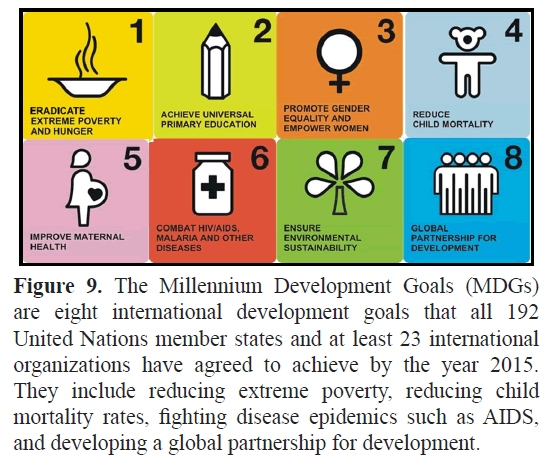
Figure 9. The Millennium Development Goals (MDGs) are eight international development goals that all 192 United Nations member states and at least 23 international organizations have agreed to achieve by the year 2015. They include reducing extreme poverty, reducing child mortality rates, fighting disease epidemics such as AIDS, and developing a global partnership for development.
The IMTA produced food crops (mainly fish, bivalves and seaweeds) are food resources which contain all major food ingredients (high protein, low total- trans- and saturated fat, high fiber-content, healthy PUFAs (EPA and DHA) against CVDs with mental disorders like mild-Alzheimer and Dementia, low ω6/ω3 ratio (van Ginneken et al 2011b), no refined sugars like fructose, (Table 1 in: van Ginneken & de Vries 2015) and as outlined in this [mini-review]: the essential vitamins and minerals, corresponding to the original Paleolithic diet.
Finally, it is important to remark that for a continent like Asia with the “new growth economies” like India and China, were more than half of the World population lives, a tremendous IR/ DM2 pandemic is expected, but that luckily the IMTA agricultural production system is historically deeply rooted in Asia.
In the past fifteen years, the integration of seaweeds with marine fish culturing has been examined and studied in Canada, Japan, Chile, New Zealand, Scotland and the USA. The integration of mussels and oysters as biofilters in fish farming has also been studied in a number of countries, including Australia, the
USA, Canada, France, Chile, Spain. The recent offshore relocation of many coastal finfish farms in Turkey has generated interest in IMTA. Recent reviews on IMTA research include a focus on seaweeds, bivalves, crustaceans and on integrated cultures from a coastal zone management perspective (see the review of Troell et al. 2009 and references therein).
Perspectives
FAO (2005) and “Think-Tank” organizations like Foresight (2011) have previously calculated our global primary green biomass production has to grow with 70% in order to cope with the “Global Ten Billion People Issue”, at the midst of the 21st Century (see [Commentary 2016] Fish&Fisheries.com in press). This amount of 70% more green biomass corresponds to the fixation of ≈70 x 1012 kg of carbon per annum. Assuming a moisture content of 80% and a fixed “Seaweed Redfield Constant” or C:N:P ratio of 550:30:1 (i.e., C:N =18:1 and N:P=30:1 -which makes the general calculation as fundament “Towards a Seaweed based Economy” seaweed species independent in the eutrophic oceans with in general terms no P or N “fertilizer” restrictions. Hence, an annual dry weight seaweed production of 350 x 1012 kg or around 350 billion kg of dry weight green biomass of seaweed needs on a global scale to be produced in order to solve “The global Ten Billion People Issue”. In comparison the Chinese seaweed industry -which at present covers≈ 90% of the global seaweed production- produces ≈10.25 billion kg of dry weight seaweed per year which is around 35 times a lower amount of green biomass (see: [Commentary 2016] Fish&Fisheries.com in press). To state it simply: we have to copy the Chinese seaweed industry towards the African continent and multiply this with 35.
A). “Land-based” systems applying desert aquaculture: We suggested (editorial) to perform this in a land-based (Sahara desert) “Ulva bioreactor” land-based systems our Blue Green technologies foundation has developed based on principle elementary knowledge of aquatic photosynthesis. This patented “Ulva Bioreactor” concept with tremendous green biomass annual production data of around 50Mt (metric) tonnes dry weight/ha/ year could be a solution to produce around ≈10.25 billion kg of dry weight seaweed per year (see editorial). Data from landbased systems indicate that seaweeds can remove between 35% and 100% of dissolved nitrogen produced by fed species. These figures, of course, depend on what specific aims the studies have had, i.e. maximization of seaweed growth or maximizing removal capacity.
B). “Seaweed-based” systems in the open ocean based on IMTA-systems aquaculture:
Keeping in mind that on the basis of the earth’s surface area which covers ≈510,000,000 km2 of which ¾ is ocean we can calculate that on our globe a tremendous area of nearly unexploited is available for humanity of around≈ 382,500,000 km2 oceanic water which can be used by cultivation of seaweeds to increase our global primary production of global green biomass. Another option –in order to cultivate simultaneously animal protein with such refined ecological engineering techniques- would be the development of gigantic floating offshore IMTA factories for which a simulation model is given in Figure 10. An urgent and compelling precondition to follow this strategy is that the IMTA cultivation technique of the several species (Figure 1; van Ginneken & de Vries 2015), is such balanced that it can operate at waste emission of zero to the vulnerable oceanic waters. According to the review of Troell et al (2009), we are at present after 15 years of knowledge development at this stage having reached such an environmental friendly cultivation system. The other prerequisite for such an “IMTA offshore oceanic farm” are the technical demands related to offshore industry in order to cope technically with extreme harsh unpredictable open ocean extreme weather conditions. Mainly in Asia several trials were performed to develop such an open ocean offshore system. In addition, in the similar review of Troell et al. (2009) and references thereindescribes technical demands and general requirements essential for open ocean offshore IMTA systems. Seaweed-based open oceanic offshore IMTA systems need to be scaled up towards commercial operating “floating factories” (Figure 10) meeting the following four demands:
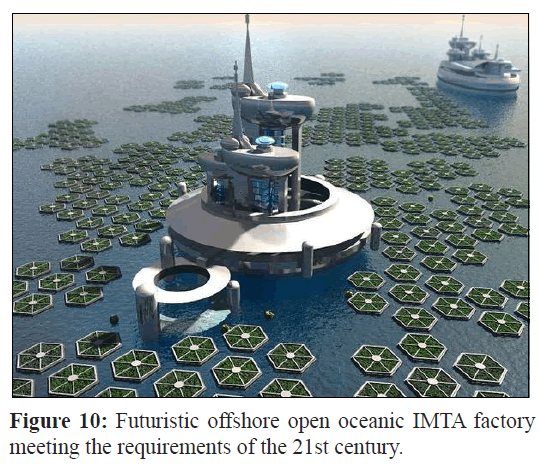
Figure 10: Futuristic offshore open oceanic IMTA factory meeting the requirements of the 21st century.
B-1: The present method to culture mainly Kelp-like seaweeds along ropes in the open ocean is too primitive for the following reasons: The complex interactive processes that connect the biomass, nutrient uptake and nutrient concentration of a balanced IMTA system can never be reached by ropeculture of Kelp in the open ocean, although Kelp culture is in our [Commentary]: this issue stipulated as one off the fundaments for a “Seaweed based Economy”. According to the review of Troell et al (2009), we are at present after 15 years of knowledge development at this stage having reached such an environmental friendly cultivation system. The other prerequisite for such an “IMTA offshore oceanic farm” are the technical demands related to offshore industry in order to cope technically with extreme harsh unpredictable open ocean extreme weather conditions. Mainly in Asia several trials were performed to develop such an open ocean offshore system. In addition, seaweed growth and performance are affected by the choice of fish species cultured, farm design, feed practices and additional site-specific parameters. The present method with culture of mainly Kelp-like species on ropes in the open ocean is too primitive e.g. in continuously depending culturing of seaweeds. As with nearshore seaweed culturing, excessive stocking density leads to light and nutrient limitations. Light conditions (i.e. water transparency) are, however, usually better in offshore environments and seaweeds can therefore be cultivated at greater depth, thus avoiding some of the problems with surface mixing and uncontrolled current movements, and even hazards to navigation.
B-2: IMTA aquaculture at zero charge exchange with the open ocean: An open oceanic IMTA factory has in order to meet Millennium goal 7 (environmental sustainability) produce green biomass and animal protein at zero charge exchange with the vulnerable open oceanic environment. This can only be achieved when the nutrient discharge by the fed (fish) component is fully balanced by the harvest of the extractive components (seaweeds and suspension- and deposit-feeders).
B-3: Technical demands for open ocean offshore IMTA seaweed culture: An important question to answer with respect to IMTA in offshore environments is whether extractive species can withstand prevailing hydrodynamic forces. In addition to strong current velocities, the acceleration due to waves and swell may cause strong forces on the cultured species and the infrastructure. Also the strong currents in some offshore situations will prevent culture of such species without appropriate attachment methods. Most of existing seaweed culture methods are not designed for open seas, and will require some form of modification to withstand the tougher conditions (especially drag forces) (Figure 11).
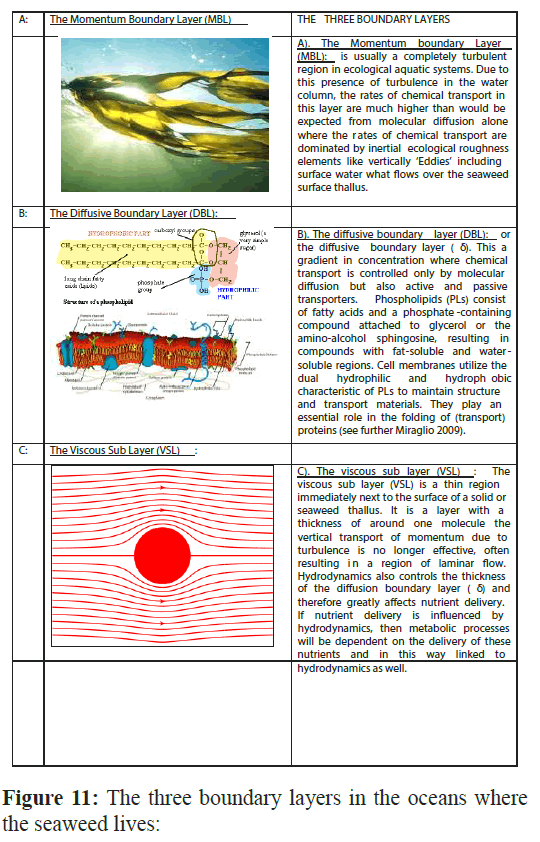
Figure 11: The three boundary layers in the oceans where the seaweed lives:
B-4: Develop an affordable open ocean IMTA offshore operating system: We have still three decades to go to overcome several technological obstacles & constraints and improve culture techniques in these floating offshore factories with zero waste charge exchange towards the open oceanic environment. However, the production process needs to be in economic terms affordable. Developing such an expensive high-tech state of the art in IMTA practices in combination to the innovative technical solutions such system requires to operate in open oceanic water with The achievement of seaweed profitability in offshore IMTA farms may require identification of species that combine effective bio-filtration and productivity with specific qualities that generate higher prices, such as sea-vegetables, nutraceuticals and cosmetics ingredients. Research devoted to the development of higher value products from seaweeds is therefore an additional step towards the incorporation of these organisms into IMTA systems.
Conclusion and Perspectives
Based on the perception of the important nexus: energy=> healthy nutrition => medical cost we give two recommendations to transform our modern terrestrial mono-stock agricultural system with its tremendous amount and lack of essential macronutritional elements (van Ginneken & de Vries 2015), and ins addition micro-nutritional elements (this review). By a further implementation of the IMTA food-production systems we hopefully can prevent and stop the predicted pandemic of IR/ DM2, but also other costly CDs among the obese and ageing human mankind, and hopefully in this way provide the conditions for a healthier world population in the 21st century (van Ginneken & de Vries 2015). We have to be aware that a proper solution lies in the field of a blending with a multi-focus scope knowledge from research areas like agriculture, aquaculture, medicine and new approaches “seaweed-based practices” to generate energy from solar irradiance. Recent advances and collective and massive reformations in the mentioned research areas the next three decades are a challenge for the Blue Green Technologies foundation (Netherlands). (www.bluegreentechnologies.nl). Our presently operating as a “Think-Tank” will in nearby months be supported by follow-up manuscripts. Hopefully this approach will convince policy makers and a wide range of professionals -whose interest relate to all aspects of the “nexus”: energy=>healthy food
a). Hydrodynamic drag forces at the seaweed thallus; b). At the “fluid mosaic membrane” of the seaweed frond; c). Hydrodynamics also controls at the molecular level the thickness of the diffusion boundary layer (δ).
=> medicine- that indeed the eight Millennium goals really can be reached this 21st century for the “global ten billion people”. That’s the mission and challenge for our foundation which hopefully will be supported and to some extent granted by these policy makers, international organizations (IDF, FAO, WHO).
Acknowledgements
This research and sharing knowledge with the “International Scientific Community” was totally funded in hours and free laborwork by the founders of the “Blue Green Technology Foundation”, the Netherlands, (www.bluegreentechnologies.nl). Mrs. Stella ter Broeken-Libre was acknowledged for her inspiring work for the Blue Green Technologies Foundation.







